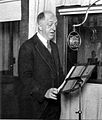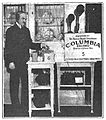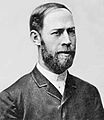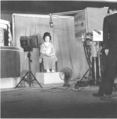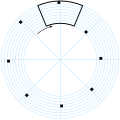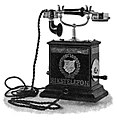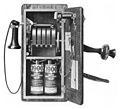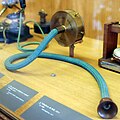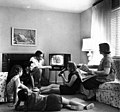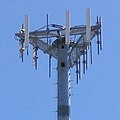Portal:Telecommunication
The Telecommunication Portal

Telecommunication, often used in its plural form or abbreviated as telecom, is the transmission of information with an immediacy comparable to face-to-face communication. As such, slow communications technologies like postal mail and pneumatic tubes are excluded from the definition. Many transmission media have been used for telecommunications throughout history, from smoke signals, beacons, semaphore telegraphs, signal flags, and optical heliographs to wires and empty space made to carry electromagnetic signals. These paths of transmission may be divided into communication channels for multiplexing, allowing for a single medium to transmit several concurrent communication sessions. Several methods of long-distance communication before the modern era used sounds like coded drumbeats, the blowing of horns, and whistles. Long-distance technologies invented during the 20th and 21st centuries generally use electric power, and include the telegraph, telephone, television, and radio.
Early telecommunication networks used metal wires as the medium for transmitting signals. These networks were used for telegraphy and telephony for many decades. In the first decade of the 20th century, a revolution in wireless communication began with breakthroughs including those made in radio communications by Guglielmo Marconi, who won the 1909 Nobel Prize in Physics. Other early pioneers in electrical and electronic telecommunications include co-inventors of the telegraph Charles Wheatstone and Samuel Morse, numerous inventors and developers of the telephone including Antonio Meucci and Alexander Graham Bell, inventors of radio Edwin Armstrong and Lee de Forest, as well as inventors of television like Vladimir K. Zworykin, John Logie Baird and Philo Farnsworth.
Since the 1960s, the proliferation of digital technologies has meant that voice communications have gradually been supplemented by data. The physical limitations of metallic media prompted the development of optical fibre. The Internet, a technology independent of any given medium, has provided global access to services for individual users and further reduced location and time limitations on communications. (Full article...)
Selected article -
The Tokyo Tower ( Tōkyō tawā, pronounced [toːkʲoː taɰᵝaː] , officially called 日本電波塔, Nippon denpatō, "Japan Radio Tower") is a communications and observation tower in the Shiba-koen district of Minato, Tokyo, Japan, built in 1958. At 332.9 meters (1,092 ft), it was the tallest tower in Japan until the construction of Tokyo Skytree in 2012. The structure is an Eiffel Tower-inspired lattice tower that is painted white and international orange to comply with air safety regulations.
The tower's main sources of income are tourism and antenna leasing. Over 150 million people have visited the tower. FootTown, a four-story building directly under the tower, houses museums, restaurants, and shops. Departing from there, guests can visit two observation decks. The two-story Main Deck (formerly known as the Main Observatory) is at 150 meters (490 ft), while the smaller Top Deck (formerly known as the "Special Observatory") reaches a height of 249.6 meters (819 ft). The names were changed following renovation of the top deck in 2018. The tower is repainted every five years, taking a year to complete the process. (Full article...)General images
Things to do
 |
Here are some tasks awaiting attention:
|
Selected biography -
Did you know (auto-generated) -

- ... that "on a good day", a Minnesota radio station could reach St. Peter?
- ... that WFMT classical music radio host Don Tait owned such a large collection of recordings that he had to buy a house and have its floor reinforced to accommodate the weight?
- ... that Dutch radio and TV presenter Hanneke Kappen presented the second Dutch radio show dedicated to heavy metal music?
- ... that a federal marshal seized a car and a truck because there was no other way to satisfy a debt owed by Arkansas television station KRZB-TV?
- ... that in 1982, a news anchor for Phoenix television station KOOL-TV was held hostage on set for five hours?
- ... that before pursuing a career in music, Lauren Jenkins was the host of a wrestling television show?
Related portals
Topics
Subcategories
Associated Wikimedia
The following Wikimedia Foundation sister projects provide more on this subject:
-
Commons
Free media repository -
Wikibooks
Free textbooks and manuals -
Wikidata
Free knowledge base -
Wikinews
Free-content news -
Wikiquote
Collection of quotations -
Wikisource
Free-content library -
Wikiversity
Free learning tools -
Wiktionary
Dictionary and thesaurus



